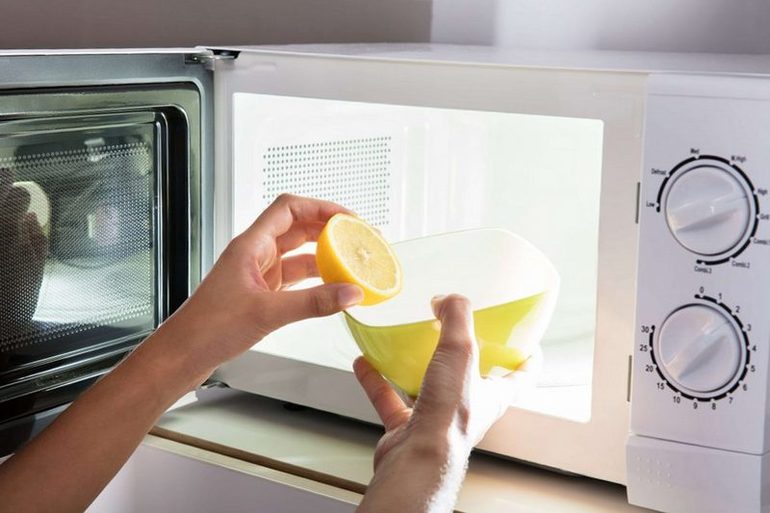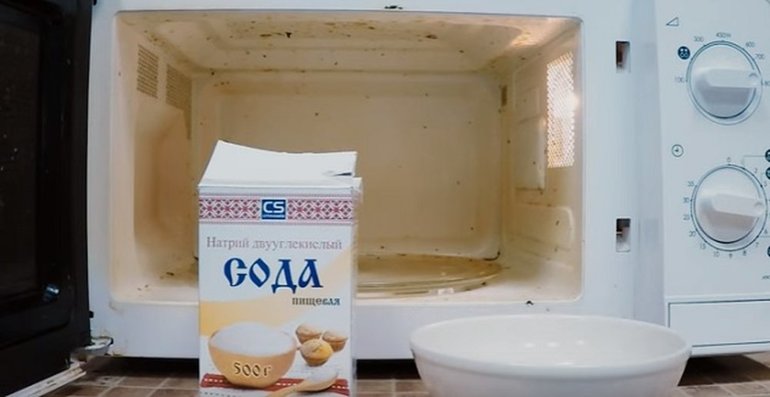How to quickly wash and bleach the microwave from fat and carbon deposits
A microwave is an indispensable tool for every housewife. Such household appliances facilitate everyday life, simplifying the preparation of various dishes or quickly warming frozen foods. But during operation, various contaminants appear in the inner chamber, so everyone needs to know how to wash the microwave.

Type of inner coating
Today on sale you can find a variety of type microwave ovens, which differ in the coatings of the working chamber. Before proceeding with the cleaning of such household appliances, it is necessary to study the instructions, determine the protective spraying used, and only then choose a specific tool or method of removing contaminants.
Microwaves are currently used with the following types of internal coating:

- enamel;
- with antibacterial bioceramic protection;
- with heat-resistant spraying.
The most modern are considered models that have an antibacterial and bioceramic inner coating. These microwave ovens allow you to save their nutrients and taste in dishes, however, such household appliances are quite expensive. The advantage of bioceramic spraying is perfect surface smoothness, high strength, low thermal conductivity, scratch resistance and preservation of the nutritional value of cooked products.
The cheapest and easiest solution to the internal chamber in the microwave is enamel painting. Often such household appliances are short-lived, due to the mediocre resistance of enamel to prolonged exposure to high temperatures. The only advantage of these microwaves is the ease of cleaning the inner chamber, as this coating has a perfectly smooth surface without large pores.
Models of microwave ovens equipped with grill and convection often receive a heat-resistant coating made of stainless steel. Such material is durable, can withstand high temperatures, but it will need appropriate care, including the use of soft sponges and a complete rejection of abrasive powders.
Use of household chemicals
In hardware stores or specialized companies that sell kitchen appliances, you can find detergents designed for microwave microwave ovens. Such household chemicals are produced in the form of a liquid, spray or aerosol. Such means should be selected based on the characteristics of the internal coating of the high-temperature chamber. Professional chemistry will allow even minimal calcium deposits to be washed well.
Cheap simplest means will not be so effective, while they have a significant drawback, namely, a specific smell. After such a thorough washing, it will be impossible to use the microwave for several days, while it is ventilated with the door open.

High-quality specialized sprays and creams are easy to use. All that needs to be done is to apply them for 10-15 minutes on the contaminated walls, and then wipe them with a non-abrasive soft sponge. Subsequently, it is recommended to carry out a neat wet cleaning using a rag slightly moistened with water. Using such products, even old stains can be washed.
To clean very dirty stoves, housewives often use self-made products based on laundry soap or wipers. Such compositions (provided that they are cooked correctly) are quite effective, can cope with various impurities, are almost completely safe for household appliances, and environmentally friendly, but in the future it will also take a long time to withstand the microwave with the door open to allow the unpleasant odor to disappear.
Traditional methods of cleaning microwaves
Many housewives refuse to use all kinds of chemistry for cleaning microwave ovens, using time-tested products and folk recipes for washing. For example, to solve problems with unpleasant odors in the microwave, you can use regular lemon. This steam treatment with citrus juice will also help in the elimination of soot and fat.
To clean the microwave oven with lemon, you will need to do the following:

- Pour up to half water in a glass jar or bowl with a volume of 500 milliliters and immerse slices of freshly cut lemon there.
- Place the container in the microwave oven, turn on the maximum heat and withstand it for about 10 minutes.
- Water boils quickly, saturated steam appears, under the influence of which the mud quickly soaks.
- All that remains to be done is to walk along the walls with a sponge or soft cloth, easily removing fat, and lemon at the same time will relieve the microwave and unpleasant odor.
Performing such self-cleaning and wet cleaning of the microwave oven, you need to remember safety, so before wiping the inner container with a cloth, you will need to unplug the cord. It is only possible to turn on the device in the network after it has completely dried.
Dense old deposits and deposits are best removed with citric acid. Such cleaning is not particularly difficult, issues with an unpleasant odor are solved, fatty deposits and calcium deposits are removed.
What needs to be done:

- Put a container in the microwave chamber, in which there is water and a lemon diluted in it.
- Turn on the microwave oven to the maximum mode for approximately 10-15 minutes.
- Such a steam treatment will be enough to clean the stove of all fat deposits.
- Wait about 10 minutes (to cool the camera), then immediately rinse the inside and out surfaces with a cloth or soft sponge.
You can use regular baking soda to remove old thick dirt inside the chamber and on the dirty lid. For this treatment, a saturated solution of 500 milliliters of water and one tablespoon of soda is prepared. The glass container with the liquid is put in the microwave, heated for several minutes at maximum power, wait for cooling, and then wipe the chamber dry with a sponge, which is also wetted in soda solution.
The simplest and quickest way to clean and refresh an old stove, having coped with the impurities present in it, is to use heat treatment using acetic solution. Such funds are especially effective in advanced cases when household appliances have not been washed for six months or more. The smell of vinegar is not very pleasant, but it quickly disappears, and the surface is easily cleaned of various impurities. With this method, it is not difficult to remove light deposits and old spots.
Such a heat treatment will require a small glass bowl, half a liter of water and 1 teaspoon of 70 percent essence (or two tablespoons of vinegar). Place a plate of liquid in the microwave and turn on for a maximum of 5 minutes. Then, without opening the door, it is necessary to withstand such a steam bath for 10-15 minutes and wipe the microwave oven with a soft brush or sponge.
The simplest life hacks
The optimal correct procedure for cleaning the microwave chamber is as follows: first they take out a ring, a glass plate, wipe the grate and the upper wall, go to the side walls, and then clean the bottom and the door itself.
To avoid long-term dense dirt and soot from food, clean the microwave oven at least once a month. This will prevent the accumulation of fat, which can be eaten into the existing spraying of the inner chamber.

To protect the microwave oven from dirt and splashes from the heated food, it is recommended to use a special plastic hood, cling film or high-quality transparent glassware.
Using vinegar or citric acid to care for a microwave with an enamel-sprayed chamber is not recommended. This can lead to the appearance of unpleasant stains and cracking of the non-stick layer.
When cleaning the stovemaximum care must be taken. Hard brushes or metal sponges are not recommended. If foreign particles get into the grate, it can ignite such household appliances.
It is strictly forbidden to use various abrasive products for cleaning, which damage the case and leave scratches and chips on the internal protective coating.
Performing the simplest wet cleaning after each use of the stove, you can prevent the formation of stubborn old spots and bleach the protective coating in the chamber. Accordingly, you do not have to carry out a comprehensive cleaning using various chemistry.
Most housewives, cleaning the stove of existing contaminants, use proven folk remedies, which are almost completely safe for the protective spray used, can eliminate traces of soot and dried fat, help cope with unpleasant odors. An old strong plaque can be eliminated only with the help of special powerful chemistry. It is recommended to carry out such a comprehensive general cleaning at home not once a year, but monthly, depending on the intensity of use of household appliances.
- How to choose a vacuum cleaner taking into account the characteristics of the house and coatings?
- What to look for when choosing a water delivery
- How to quickly create comfort at home - tips for housewives
- How to choose the perfect TV - useful tips
- What to look for when choosing blinds
- What should be running shoes?
- What useful things can you buy in a hardware store
- Iphone 11 pro max review
- Than iPhone is better than Android smartphones



